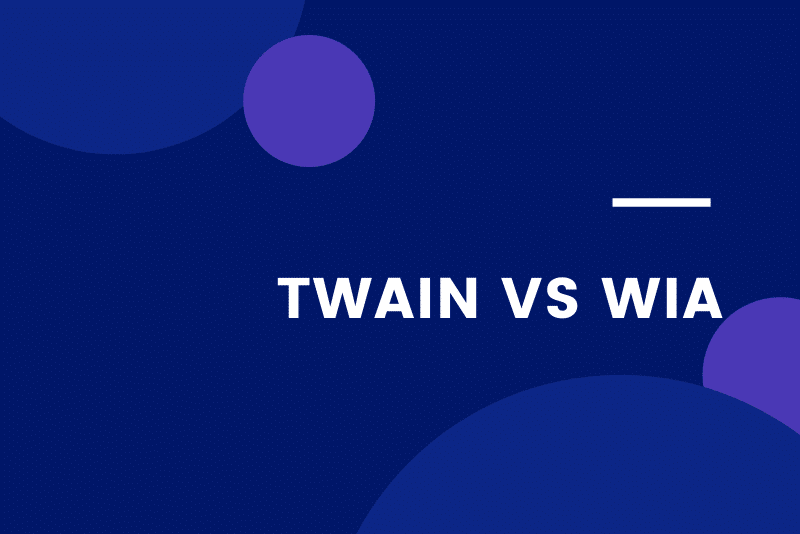The increasing usage of image acquisition devices such as scanners is a result of the realization of the importance and value of incorporating images into documents and other projects. To be able to access these image acquisition devices, application developers had to create a user interface that could synchronize and communicate with the particular scanners to access the raster data (images). It was difficult and costly for the app developers because once the devices’ features and capabilities are upgraded, the application developers would also need to upgrade for the specific scanners and devices. To resolve this issue, manufacturers and developers of these devices and software came together to create a consistent and simple means of standard communication between their products (that is the imaging device and software). This led to the development of TWAIN and its likes (WIA, ISIS).
In this article, we would be looking at two of the most popular APIs, TWAIN from TWAIN working group and Microsoft’s WIA. We would explain what they are, their benefits, and explore some of their differences in characteristics.
Table of Contents
TWAIN

The development of TWAIN began in 1991 after a group of representatives from several companies such as Aldus and Hewlett-Packard came together with the ultimate goal of creating an open multi-platform solution that easily interconnects raster input devices with application software. In the course of the development, the group took various objectives into consideration to produce an all-around effective product. They are; an application with an encapsulated human interface, effective integration, ease of adoption by different applications, and extensibility to different operating systems.
TWAIN is a widely used standard application programming interface (API) and protocol for the communication between software applications where images can be imported and imaging devices (cameras, scanners). It provides support for production, high-speed scanning, digital cameras, and ICC color profiles.
The API consists of the three major elements that make the transfer of data possible. They are, the application software, to which the image is to be transferred into; the source manager software, this is basically the code that overlooks the interaction between the app and the device; and the source software, the software that controls the imaging device. You should also know that for it to be possible to use the TWAIN interface, the user application driver and the imaging device driver must support TWAIN.
Benefits of using TWAIN
The use of TWAIN has major advantages for the application developers, the source developers, and the end-users.
For the application developers, they can offer users of theory applications an easy way to collect images from any compatible raster device without having to leave the application and helps save time and money as they do not need to write, support, or ship low-level drivers for scanners. It also cancels out the need for your application to provide a user interface to control the image acquisition process.
Meanwhile, source developers can provide proprietary user interfaces for their devices. Most importantly, it grants the end users to experience a quick and effective way to incorporate images into their documents.
WIA

WIA (Windows Image Acquisition) was introduced by Microsoft as part of Windows me in 2000 when it was initially offered as an on-demand service. It was later integrated into other Windows versions as a standard imaging device and API model. As other Windows versions emerged, there have been various enhancements in WIA like the release of the WIA library tool in 2002 that enables the addition of support for ADF scanners and a snapshot filter driver and the capturing of still images from videos. WIA 2.0 was released in Windows Vista.
Windows image acquisition is basically a device driver interface and API that overlooks the interaction (the acquiring and transferring of digital images) between applications and imagine hardware devices. Simply put, it enables those applications to communicate with various scanners and digital devices without the device manufacturers and software writers having to configure their products to be compatible with each other.
Benefits of WIA
Though not as sophisticated as TWAIN, using WIA a lot of pros that are utilizable by application developers, device manufacturers, and scanner users alike. Some of the benefits are:
- It maintains the image properties after the data transfer
- The applications can be directly initiated from the interface using the scanner scan button
- The WIA drivers are loaded in the service process, providing a more driver environment
- Users can take advantage of various add-ons like segmentation filters.
- It grants users a stable and reliable scanning experience as WIA isolates the driver and the app.
Comparative characteristics of TWAIN and WIA
TWAIN characteristics
- TWAIN is compatible with Windows, Mac, and Linux operating systems.
- It has 3 different transfer modes namely native, memory, and fine.
- Device vendors are allowed to customize their user interface for each driver.
- When you want to work with sophisticated scanner features, TWAIN is best.
- For a device that supports TWAIN and WIA, TWAIN is better for scanning.
- Its usage is not limited as it is designed to use automatic document feeders (ADF).
WIA characteristics
- WIA is only compatible with the Windows OS.
- Unlike TWAIN, WIA has two transfer modes; memory and file.
- Uses a custom user interface for all devices.
- WIA it’s mainly used when you need basic scanner features.
- When the device supports both TWAIN and WIA, it’s better to use WIA for image acquisition from cameras and video devices.
- It’s usage is limited to scanners and cameras because the API is not designed to use ADF.
Conclusion
TWAIN and WIA are both very effective image acquisition programs. Though they have similar basic functions, TWAIN offers a more flexible interface and more functionalities.
